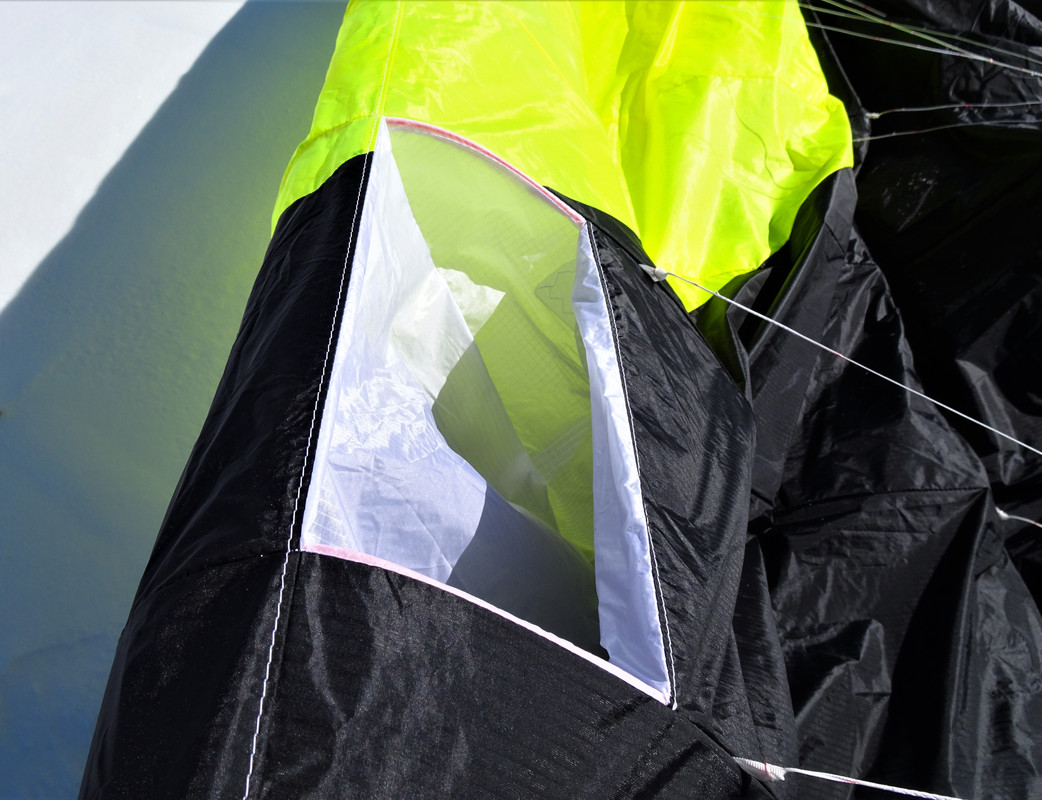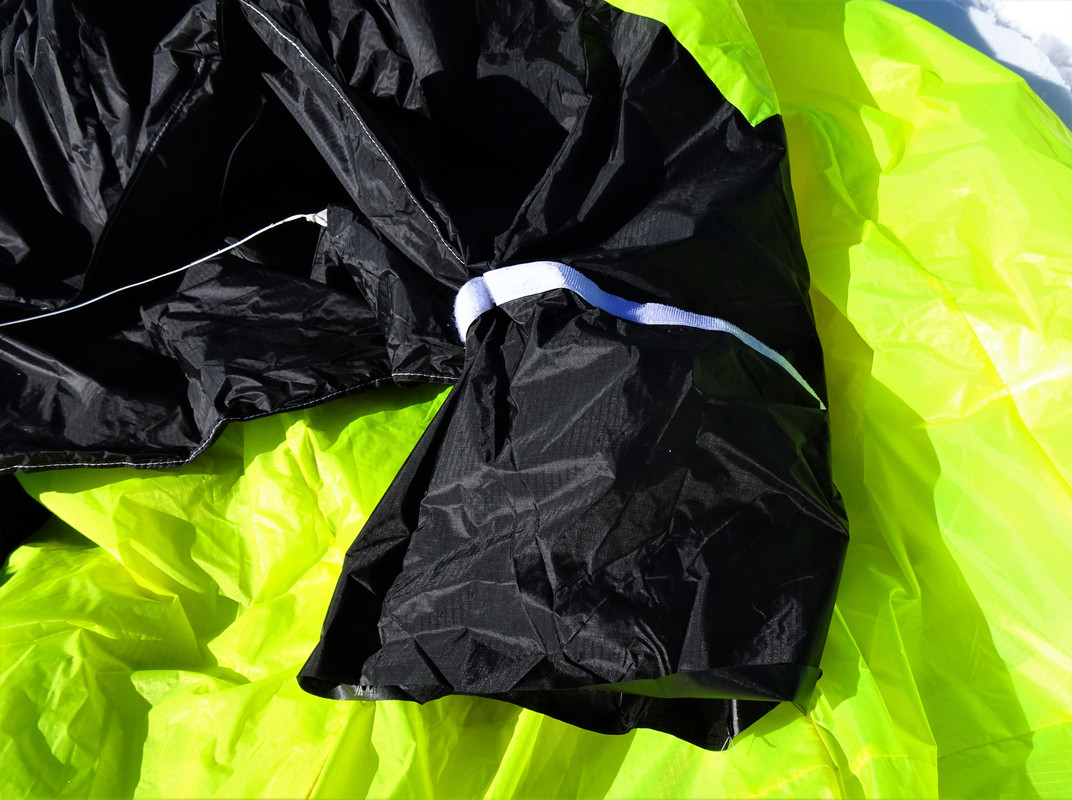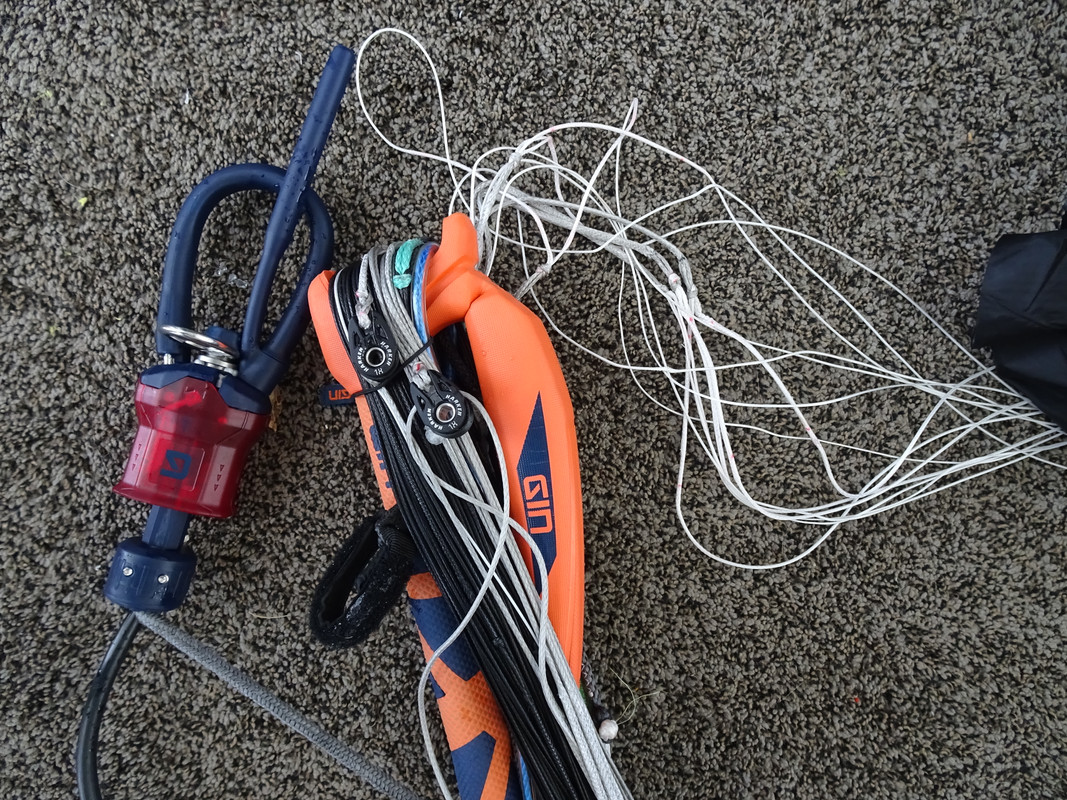So I've been getting a little bit of time on the Gin Spirit - definitely need to get more time on it but thought I would share some 1st impressions.
I ended up having a pretty fun moonlight session last night on in some light but steady ~8 kt winds. As you might imagine, not a whole lot of
pictures from that session, but it was fun and felt like the 1st time where I was really starting to see some of the behaviors of the kite.
I guess maybe I'll start with some pictures and more general design features. The construction is pretty technical with all the bells and whistles of
similar kites in this category like the FS Soul - things like leading-edge stiffeners the entire leading edge, spanwise load strips, etc. The inlets
are highly formed and made for gulping air as you can see in the pic below. This does lead to a very quick inflation. It uses a velcro deflate
valve located on the center trailing edge, and rather than having velcro dirt-outs at the tips, it just has a permanent small exit hole there.

A look at the Inlets:

Deflate Valve:

Tip Dirt Outs

A look at the bar and bridles:

Weight of the 15m Spirit is 2.38 kg which puts in in between 2.17 kg for a 15m Matrixx and 2.45 kg for a 16m Empulse by comparison, and in the lite
category, maybe not UL. I don't know the exact materials used in the Spirit, but these weight figures lead me to believe they are using a mix of 20D
and 30D fabrics, and that things like LE stiffeners and higher cell count make for the slight extra weight over the ones mentioned.
I'm going to go ahead and base my comparisons to the other closed cell kite I currently have the most experience with, the Little Cloud Pelican 2.
While I realize not a ton of people have had a chance to fly either of these kites, I've found myself thinking a lot about their differences and it
opens up conversation to much bigger ideas such as performance, what defines a "good" kite, and design intent. Hopefully later on people who have
access to other kites such as the Hyperlink, Chrono and Soul can add their perspectives and round out the conversation.
First Impressions: I'll start off by saying expectations for this kite were very high, and it has not let me down. Like all the
other kite brands that are descendants of paraglider companies, quality is absolutely top-notch. Handling characteristics too, are excellent. As
mentioned, the kite inflates very quickly. It also keeps its shape really well once inflated, and is quite stable. You can get some very slight
tip-tucking on a really hard turn, but it pops out quickly once you exit. Bar pressures are pretty light and responsive, just overall a very solid
feel, and a kite that makes you feel at home right away, with no weird tendencies.
In really light winds - say sub 6kts - I think other kites like the Pelican, Empulse and Matrixx might do a little better at hanging out and waiting
for the next puff of wind. I would contribute this almost entirely to the lighter weight of these kites. The Spirit will do a little more hunting in
really light and variable winds, as the cleaner leading edge of the Spirit causes it to surge a bit quicker and this might need to be checked and
redirected a bit more proactively if the winds are not steady to avoid an overshoot. But lets face it sub-6kts isn't really useful wind anyway unless
you're on a really hard surface, and once winds pick up a bit more, it becomes clear that the Spirit is the more powerful kite out of the set.
There Spirit definitely has some lift - I would say it is most comparable to the HQ Zeekai out of any of the previous kites I've flown. Maybe a
little sharper pop with not quite as much glide as the Zeekai. But that kind of makes sense as the Spirit is a 15m and Zeekai I have is is a 16m.
The surge, or Pop, is also stronger than probably any other kite I've flown. While I've only had a chance to test in light winds, the lift varies
considerably with increases in wind and speed, and I was able to eek out some pretty nice jumps even with only 8-10kts of wind last night. Everything
I've seen so far, and everything I'ver heard about the smaller sizes - is that these are going to be Big Air machines. I'm not a great jumper, but it
does make it quite effortless. But to consider the Spirit as being a better-handling, more stable version of the Zeekai is a pretty big compliment in
my books. The Zeekai has always been one of my favorite kites for light winds - just because it can develop so much lift at low speeds - and now with
the Spirit, I think you have a kite that will have a wider range of use for the average rider.
Other characteristics that are standing out: It sits quite far forward in the wind window and I believe it is going to be pretty efficient. In a
really tight, powered turn with the bar pulled all the way back, you can choke it - kind of like a muted version of the Gin Shaman3. At that point it
will stop pulling asmhard and turn quickly. Once you push the bar forward, it exits with a nice boost of power. The turns do not feel as powered and
as carving as say the HQ4 Montana X or LC Pelican (more on this later). Holds air really well, the reverse launch is really easy - all kind of the
things you'd expect from a high-end kite.
What's the best kite out there?
So maybe the one thing that stands out most after testing the Spirit and other kites like the Little Cloud Pelican - is this whole question of what
makes a good kite, and what makes one better than another. Comparing the Gin Spirit to my experiences with the LC Pelican - one thing became very
clear: these are two very capable kites that were designed with two really different sets of goals and objectives in mind. Interestingly, at the
surface level it might seem like the kite designs are the same: both are closed-cell, designed to excel at foilboarding as well as snowkiting. But
beyond that, there are some definate design goal differences. The Spirit was designed with Big Air clearly being a top criteria - a kite that is
going to be massively fun for mountain boarders, freestylers and water fanatics. On the other hand, it's obvious that one of the top design criteria
for the Pelican was back-country mountain performance. The result is two markedly different kites, each excellent at what it was designed for.
I'll offer up a couple talking points as kind for what I'm talking about, and the resulting differences in design.
1. Wing curvature
One of Tom Bourdeau's signature design features that is evident in kites such as the Pelican, Empulse and all Montana versions since the M8 - is a
pretty radical curvature and C-shape to the planform. The Spirit has a much flatter curve than the Pelican. This gives the Spirit better lift and
boosting ability. What the higher C-shape of the Pelican does is make for a quick-turning kite with a more powered, carving-type turn. This becomes
important for a kite that is designed to spend a lot of time looping and pulling a person up a mountain. Tight, powered loops are really important
on steep slopes where you need lots of power continuously and your available wind window is compressed.
The power these kites produce in the turn ended up being more noticeable than I was expecting. On the Pelican, as you loop the kite the power stays
near-constant and you almost get this kind of satellite/slingshot effect. So far the feeling that I've got on the Spirit - at least in lighter winds
- is that the power falls off a bit during the turn but builds very nicely on the exit. Any disadvantage in this regard on the Spirit is repurposed as
overall improved lift and Pop.
2. To Stiffen or Not to Stiffen
The Gin Spirit has a much more technical leading edge than the LC Pelican, with stiffeners that go the entire span. This creates a really clean
leading edge profile. Once the kite decides to grab, it moves very quickly through the wind window, developing lots of lift quickly. This translates
into a healthy surge of lift and good Pop - exactly the sort of thing you are looking for in a Big Air kite.
The Pelican on the other hand has no stiffeners. This has been an intentional choice by the designer for years now, and it does a couple of things.
First, it makes it really easy to pack the kite away with very little fuss. It makes the kite lighter, smaller, more stuff-able since you don't have
to worry about deformation or damage to the battens. The other thing it does is offer some inherent stability and overshoot prevention to the kite.
As the kite gets close to the edge of the wind window, it tends to lose a bit of internal pressure and the leading edge deforms a bit. This
deformation decreases lift and increases drag - making it harder for the kite to overshoot. All this does of course come at the expense of some Pop
performance - but if you are designing a mountain kite, you might be ok with that. In fact, you might actually want that.
I can tell that I am going to really like the Pop and performance of the Spirit; with that said, it is not a kite I see myself taking into the
mountains any time soon. Between the nicely formed battens that I am just a little more nervous about warping, and the more agressive lift of the
kite - I'm just not sure I'd feel comfortable. Keep in mind this has nothing to do with stability. The Spirit is a very stable kite. In some ways,
it may be more stable and rigid than the Pelican. But stability doesn't always equate to comfortability. There is something about the smooth power
delivery of the Pelican that leaves me feeling very comfortable in gusts. Even after getting schwacked and having the kite fold up, rarely do I worry
about the surge when it re-opens - it just feels really controllable and like it doesn't want to kill you.
But this same agressive power spike on the Spirit is going to be exactly what makes it more desirable for others. While the Pelican has some really
nice float, the Spirit is clearly the better boosting kite of the two.
So which is the better kite? The answer is, it really depends on what you are looking for. The perfect person for the LC Pelican is someone who
wants a kite that they can use on water, has some fun lift and float, but that also performs really, really well for back-country skin-ins and
technical tours. The Spirit on the other hand is going to be great for the person who does mostly Park-and-Ride snowkite riding, and who loves
sending it and going big wherever they are - land or water. Both really great kites for slightly different tastes.
Anyhoo - just some first impressions and thoughts - hopefully, that is helpful to someone.
Founder/Owner
Colorado Kite Sports
Specializing in Gin, Little Cloud & HQ4 foils.
http://coloradokitesports.com
Most used Kites: LC Pelican, Gin Marabou
Skis: Something w/ Marker Baron or Duke Bindings
Boards: Litewave Wing, Naish Jet 2000, OR Mako 140